AMD Ryzen 9 7950X3D vs Intel Core i9-13900K Faceoff: Battle of the Gaming Flagships

The AMD Ryzen 9 7950X3D vs Intel Core i9-13900K rivalry is a battle of flagships for the highest-end of the gaming market, but the chips take drastically different approaches to serving up leading performance. The Core i9-13900K wields Intel's 13th-Gen Raptor Lake x86 hybrid architecture to square off against AMD's chiplet-based Zen 4 Ryzen 7000 chips, but AMD has a trick up its sleeve — the Second-Gen 3D V-Cache tech, which fuses on a 3D-stacked cache chiplet atop the processor to deliver market-leading gaming performance. These two fundamentally different approaches have shaken up our list of the best CPUs for gaming, but each approach has its respective strengths.
AMD's $699 Ryzen 9 7950X3D is geared specifically for gamers looking to blast through CPU-limited games while still having the threaded heft of 16 cores that remain competitive in the heaviest of productivity workloads. The Ryzen 9 7950X3D does lag competitors in some productivity apps due to the tradeoffs associated with the 3D chip-stacking tech, and it doesn't accelerate all games equally. However, one thing is certain — it is the fastest gaming chip on the market.
The $589 Intel Core i9-13900K is Intel's fastest gaming processor, and while it isn't quite as fast as AMD's Ryzen 9 7950X3D in gaming, it has a much friendlier price tag and serves up ultra-competitive performance in both gaming and productivity apps. Intel also continues to support DDR4 memory to offer a less-expensive path for builders, lowering the bar for entry to flagship performance even further. Meanwhile, AMD's decision to support only DDR5 has proven to be a pricing pain point.
The different strengths of these two chips make for a difficult decision if you're looking to pick one for your next high-end build. Below we've taken the Core i9-13900K vs Ryzen 9 7950X3D rivalry through a six-round faceoff to see which chips take the crown in our gaming and application benchmarks, along with other key criteria like power consumption and pricing. Let's see how they stack up.
Features and Specifications: AMD Ryzen 9 7950X3D vs Intel Core i9-13900K
| Street/MSRP | Cores / Threads (P+E) | P-Core Base / Boost Clock (GHz) | E-Core Base / Boost Clock (GHz) | Cache (L2/L3) | TDP / PBP / MTP | Memory | |
|---|---|---|---|---|---|---|---|
| Ryzen 9 7950X3D | $699 | 16 / 32 | 4.2 / 5.7 | 144MB (16+128) | 120W / 162W | DDR5-5200 | |
| Core i9-13900KS | $699 | 24 / 32 (8+16) | 3.0 / 6.0 | 2.2 / 4.3 | 68MB (32+36) | 150W / 253W / 320W | DDR4-3200 / DDR5-5600 |
| Core i9-13900K / KF | $589 (K) - $564 (KF) | 24 / 32 (8+16) | 3.0 / 5.8 | 2.2 / 4.3 | 68MB (32+36) | 125W / 253W | DDR4-3200 / DDR5-5600 |
AMD’s $699 Ryzen 9 7950X3D comes packing sixteen Zen 4 cores and the company’s second-gen 3D V-Cache tech that unlocks 128MB of L3 cache, a combo that delivers the fastest gaming performance available on the market. The 7950X3D has the same underlying design as the Ryzen 9 7950X with a central I/O die and two eight-core compute chiplets that provide a total of 16 cores and 32 threads.
Unlike the standard 7950X, one of the 7950X3D's compute chiplets comes with an additional 3D-stacked L3 cache and boosts to 5.25 GHz. Meanwhile, the 'standard' compute chiplet without cache boosts to 5.7 GHz, the same as the standard 7950X (details here). Despite the lower frequency, the cache-equipped chiplet provides the best performance for games, while the faster chiplet is best for productivity applications. As such, AMD designed an innovative new driver that helps steer threads for different types of workloads to the correct chiplet.
The Ryzen 9 7950X3D brings all of the amenities we would expect from a modern processor, including support for DDR5, PCIe 5.0, and the latest USB connectivity standards. AMD has also added integrated graphics for a basic display out for the first time, which is a plus if you need to troubleshoot. You can see our iGPU testing here.
The 7950X3D sips power — it has a base TPD of 120W and a max 162W PPT, which is 68W lower than the 170W/230W rating for the standard 7950X. The lower power threshold will result in less performance in heavy applications, but you'll still need to plan for a 240mm to 280mm AIO (or better) for the best performance.
The Ryzen 9 7950X3D requires an AM5 motherboard, so pricey DDR5 memory is the only option. Unfortunately, DDR5 continues to be much more expensive than DDR4 memory. Granted, that pricing pressure isn't as much of a consideration at the high end, but you should factor it into your purchasing decision. The AM5 platform is new, so the Ryzen 7000 chips aren't backward compatible with older AM4 motherboards. However, AMD will support the AM5 platform until 2025+.
AMD only allowed overclocking the memory and Infinity Fabric for the previous-gen 5800X3D, but the 7950X3D also adds support for both the auto-overclocking Precision Boost Overdrive (PBO) and the Curve Optimizer. Unfortunately, AMD still doesn’t allow direct frequency overclocking due to a voltage limitation for one of the chiplets.
Intel's $589 sixteen-core Core i9-13900K comes with eight hyper-threaded P-cores and 16 single-threaded E-cores, for a total of 32 threads. That's an increase of eight additional E-cores over the previous-gen Core i9-12900K, equating to more threaded horsepower. You can also save some cash with the $564 Core i9-13900KF, which has identical specs but lacks the integrated GPU.
Intel still uses the 'Intel 7' process node for Raptor Lake but leveraged a newer revision of the silicon to push clock speeds higher while improving power efficiency. The P-cores come with a 3.0 GHz base, but, more importantly, a 5.8 GHz boost that's a whopping 600 MHz increase over the prior gen. Meanwhile, the E-cores now have a 3.0 GHz base (+600 MHz) and stretch up to 4.3 GHz (+400 MHz), meaning that not only do you get more E-cores, but you also get more out of each core.
The Core i9-13900K is also equipped with 32MB of L3 cache and 36MB of L2 and drops into existing 600-series motherboards or the new 700-series models. The chip comes with the integrated UHD Graphics 770 engine with 32 EUs that boost up to 1.65 GHz.
Intel's chips now have a Processor Base Power (PBP) value instead of a TDP metric, and a secondary Maximum Turbo Power (MTP) value that denotes the highest power level during boost activity. The 13900K comes with 125W PBP (base) and 253W MTP (peak) power ratings, but be aware that the chip can always operate at the 253W MTP when it is under load, though the actual power use will vary with application intensity. Intel allows full overclockability, but only when you pair the chip with a Z-series motherboard.
Winner: Tie
The Core i9-13900K vs Ryzen 9 7950X3D battle yields a tie in this category. Both chips support DDR5 and the PCIe 5.0 interface, meaning neither has an inherent connectivity advantage.
Intel has the advantage of backward compatibility for DDR4 and the 600-series chipset, enabling lower-cost memory and motherboards for value seekers (caveats apply). Intel also has its Raptor Lake Refresh chips on the horizon, meaning there will be one more generation of upgrades for the LGA 1700 platform.
AMD's new AM5 platform only supports pricey DDR5 and carries a premium over the Intel motherboard ecosystem, but it does afford extended forward compatibility — AMD plans on supporting the AM5 platform until 2025+.
Given its new hybrid architecture with two types of cores, Intel's core counts aren't directly comparable to AMDs due to their different capabilities. Our performance results will dictate the performance value of the overall designs.
Gaming Benchmarks and Performance: AMD Ryzen 9 7950X3D vs Intel Core i9-13900K
Remember, this article is an overview of our much more in-depth testing in our AMD Ryzen 9 7950X3D Review. Below you can see the geometric mean of our gaming tests with the AMD Ryzen 9 7950X3D vs Intel Core i9-13900K at 1080p and 1440p, with each resolution split into its own chart. As usual, we're testing with an Nvidia GeForce RTX 4090 to reduce GPU-imposed bottlenecks as much as possible, but differences will shrink with lesser cards or higher resolutions.














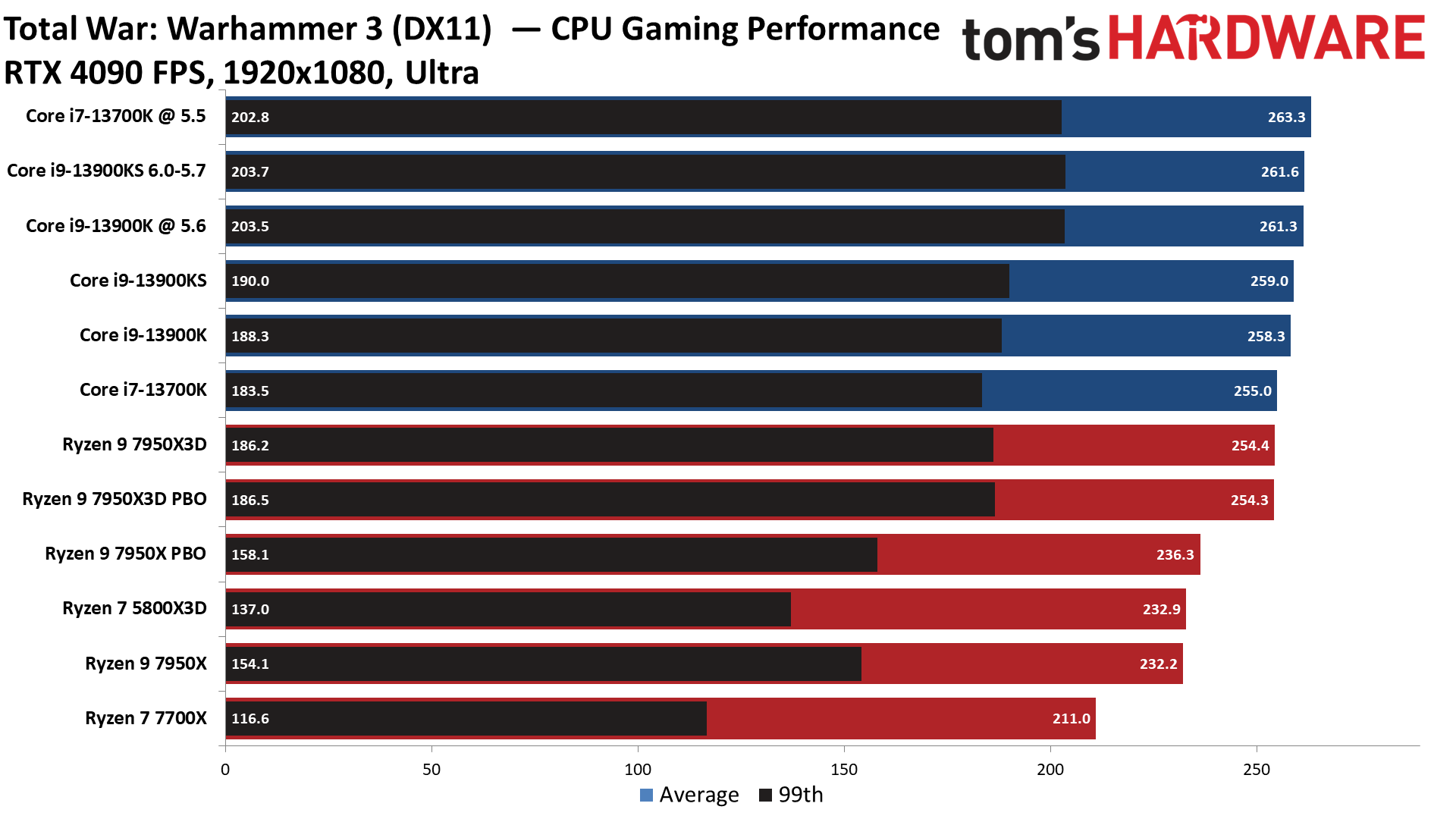



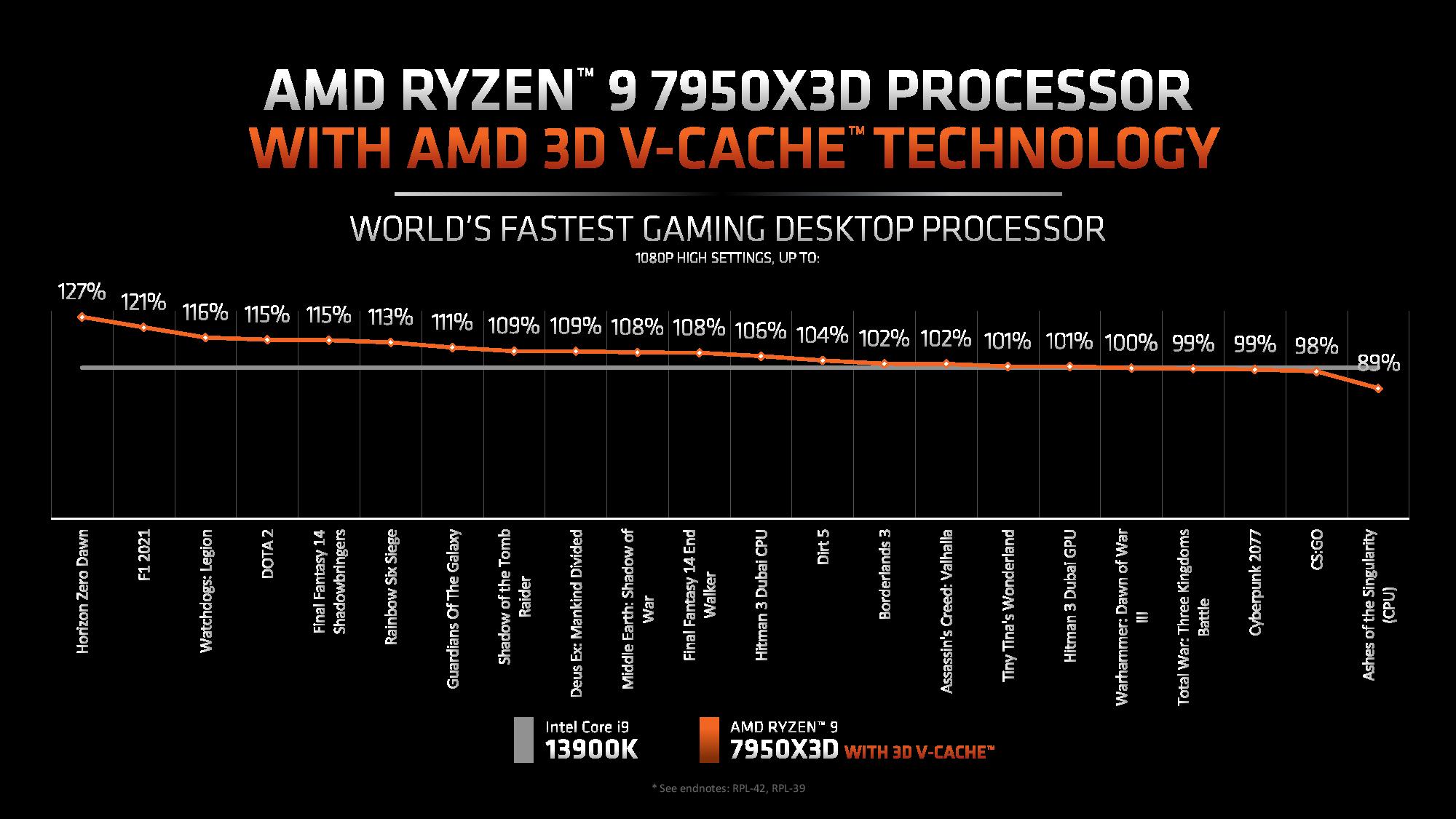
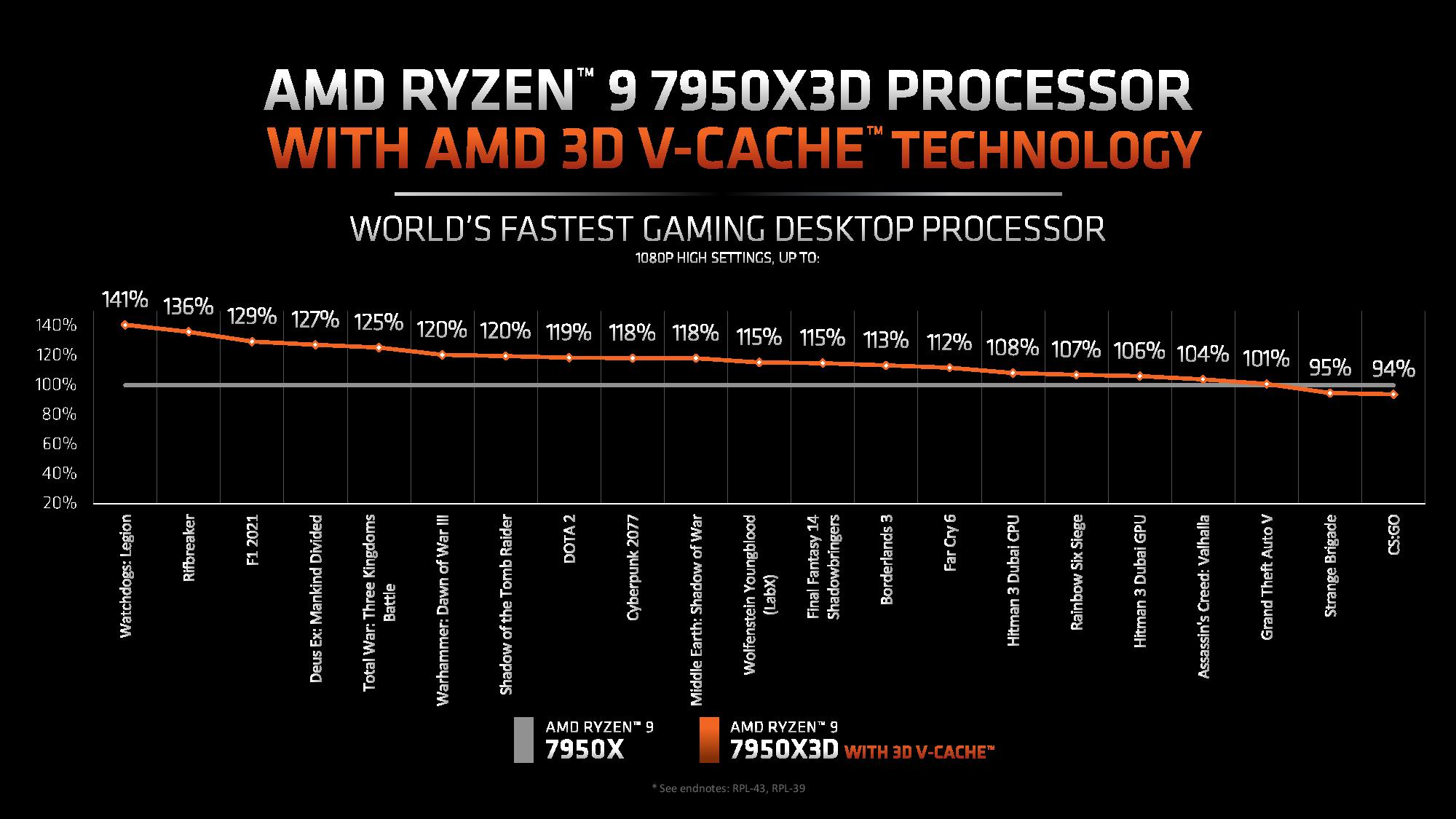
The Ryzen 9 7950X3D lives up to its billing as the fastest gaming chip in the world, beating out Intel’s flagship by impressive margins in some titles. We also see the 7950X3D take a big lead in the geometric mean of our test suite, but be aware that the 3D V-Cache doesn’t accelerate all titles equally. Therefore, you should also look at the individual game benchmarks in the above album to assess the overall trend.
In our testing, the $699 Ryzen 9 7950X3D is 12% faster than the $589 Core i9-13900K at 1080p gaming at stock settings, and 9% faster when the chips are overclocked. The latter score is discouraging for Intel — the 13900K consumes far more power yet still can't beat the 7950X3D. As a reminder, Intel released its limited-edition Core i9-13900KS as a preemptive strike against the 7950X3D, but despite its impressive 6 GHz boost clock and big price tag, it offers basically the same gaming performance as the $589 Core i9-13900K. As such, it also falls behind the 7950X3D.
While the 7950X3D is 12% faster than the 13900K in this selection of titles, it also costs 19% more. As mentioned above, you can also equip the 13900K with DDR4 to save even more cash, but be aware that you'll lose a few percentage points of gaming performance on average (see our testing here).
Moving over to 1440p pushes the bottleneck more towards the GPU, so the difference between the chips shrinks. For example, the Ryzen 9 7950X3D is 8% faster than the Core i9-13900K at 1440p, and that shrinks to a 3% difference after both chips are overclocked. It's logical to assume that most high-end gaming systems will use higher-resolution monitors, so the differences could be slight, but the 7950X3D will give you more headroom for future GPU upgrades.
Be aware that large deltas in individual game titles, as we see with the Ryzen 9 7950X3D, impact cumulative measurements. You can see examples of that in titles like Microsoft Flight Simulator 2021, Far Cry 6, and F1 2021. Our test suite heavily favors the improvements from 3D V-Cache, so we also included a table below with results from an additional five games that we don’t normally test. You’ll also find AMD’s own benchmarks in a broad range of titles at the end of the above album to give you an idea of performance gains in other titles. As with all vendor-provided benchmarks, take AMD's slides with a grain of salt.
As always, the AMD vs Intel competition can vary based on the title and the GPU you use, so it's best to make an informed decision based on the types of titles you play frequently.
| Tom's Hardware - 1080p Extras | Ryzen 9 7950X3D | Core i9-13900K | 7950X3D vs 13900K |
| Grand Theft Auto V | 182.4 fps | 185.5 fps | -1.7% |
| Project Cars 3 | 357.6 fps | 295 fps | +21.2% |
| Shadow of the Tomb Raider | 332.2 fps | 274.6 fps | +21% |
| Borderlands 3 | 231.6 fps | 186.4 fps | +24.3% |
| Horizon Zero Dawn | 264.7 fps | 218 fps | +21.4% |
Winner: AMD Ryzen 9 7950X3D
On average, the Ryzen 9 7950X3D is the fastest gaming chip money can buy. In our test suite, the Ryzen 9 7950X3D is 12% faster than the Core i9-13900K at 1080p gaming and 8% faster at 1440p. After overclocking, those deltas shrink to 9% and 3% at 1080p and 1440p, respectively.
These gaming results come with a few caveats: The 7950X3D doesn't accelerate all games, and the Core i9-13900K costs 19% less before we factor in its much lower overall platform costs. However, you'll always pay a disproportionate premium for leading performance, and at the end of the day, a win is a win.
As always, we don't recommend chips in this price range if you're only interested in gaming — you'll find lower-priced alternatives from both AMD and Intel that are a far better value for gaming. However, there will always be those determined to build the absolutely fastest gaming system regardless of cost, and the Ryzen 9 7950X3D is the fastest gaming chip currently available for those high-end builds.
Meanwhile, the rest of us should probably wait to see how the eight-core $449 Ryzen 7 7800X3D fares when it arrives in April. This chip will likely offer nearly the same gaming performance as the Ryzen 9 7950X3D, but at a much lower price.
Productivity Performance: AMD Ryzen 9 7950X3D vs Intel Core i9-13900K
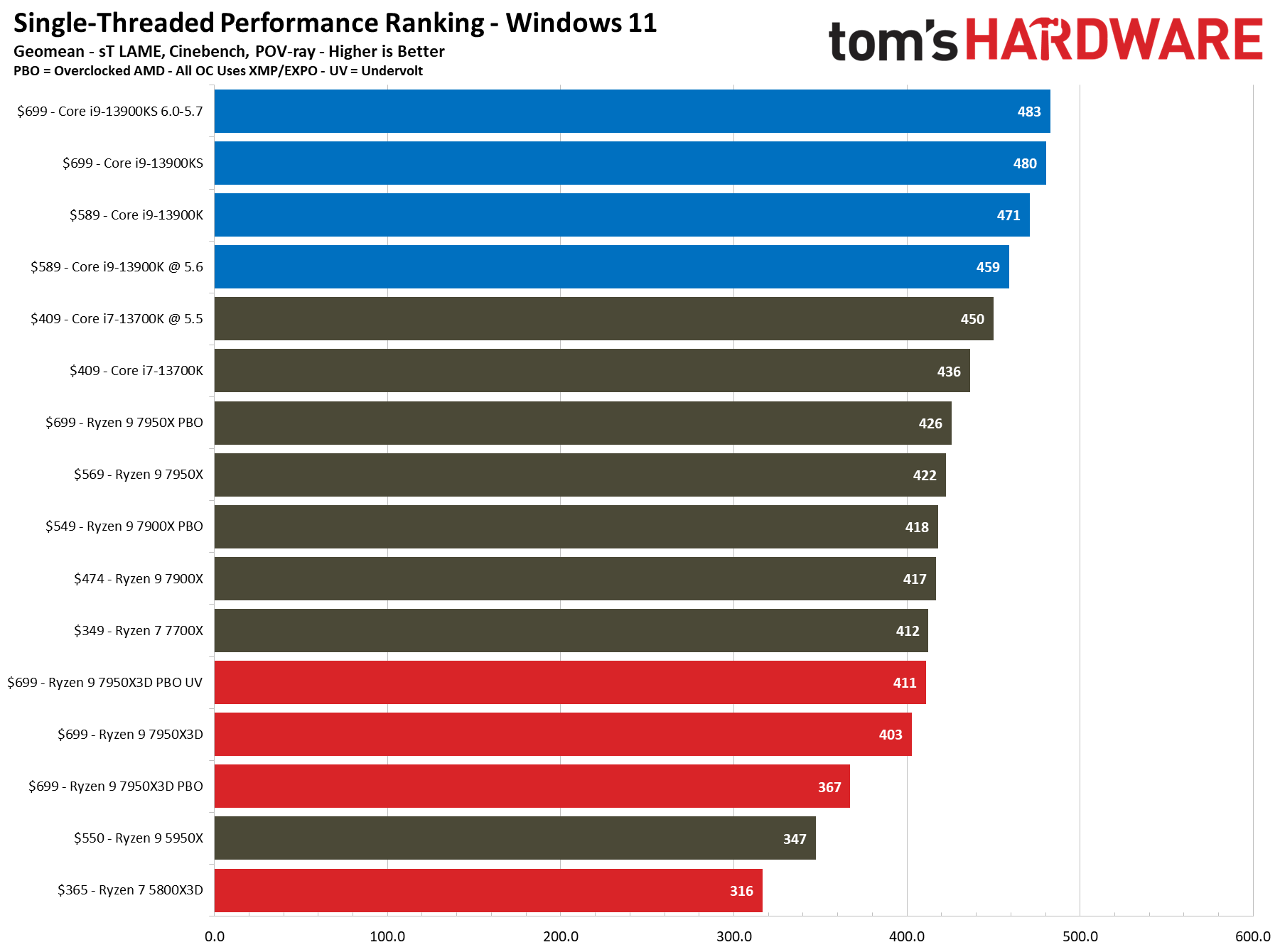


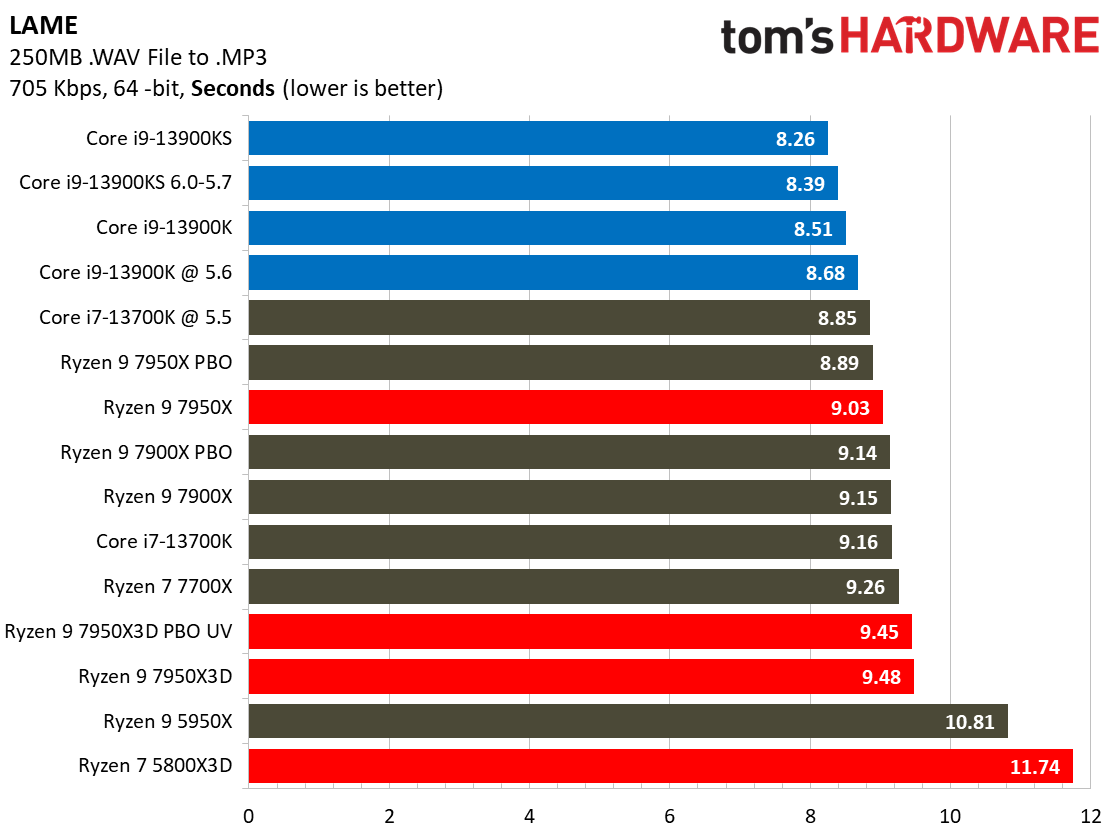




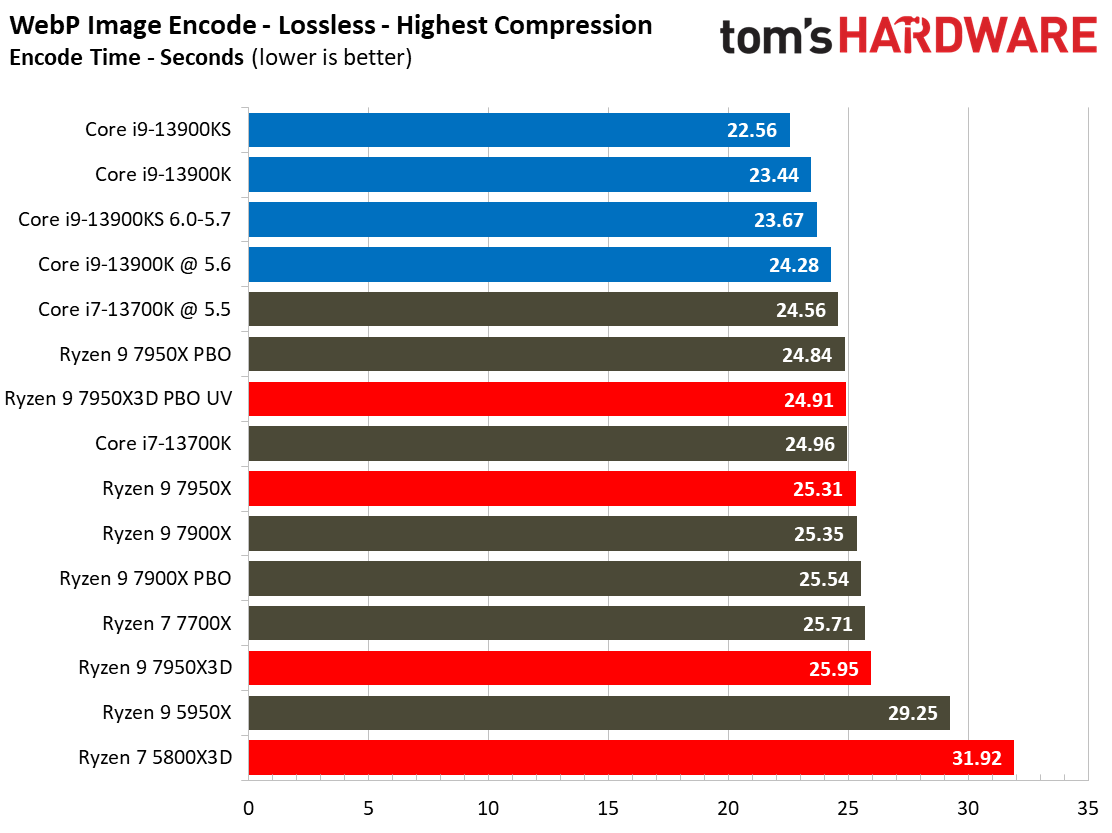


We can boil down performance in productivity apps into two broad categories: single- and multi-threaded. The first slide above shows the geometric mean of performance in several of our most important tests in the single-threaded category, but be sure to look at the expanded results in the above album.
The Core i9-13900K is 17% faster than the standard Ryzen 9 7950X3D configuration in single-threaded work. We have two overclocked configs here for the 7950X3D — the auto-overclocked PBO, and PBO combined with undervolting (PBO UV). Notably, the PBO UV config narrows the 13900K’s lead in single-threaded work to 11%.
Naturally, those performance deltas won't carry over to every type of workload. However, flipping through the album of test results reveals that the Core i9-13900K excels in single-threaded work, which would ultimately provide snappier performance than the 7950X3D in light applications. The Ryzen 9 7950X3D does lead in the AVX-512 y-cruncher benchmark, but Intel leads all other lightly-threaded benchmarks.
Get Tom's Hardware's best news and in-depth reviews, straight to your inbox.



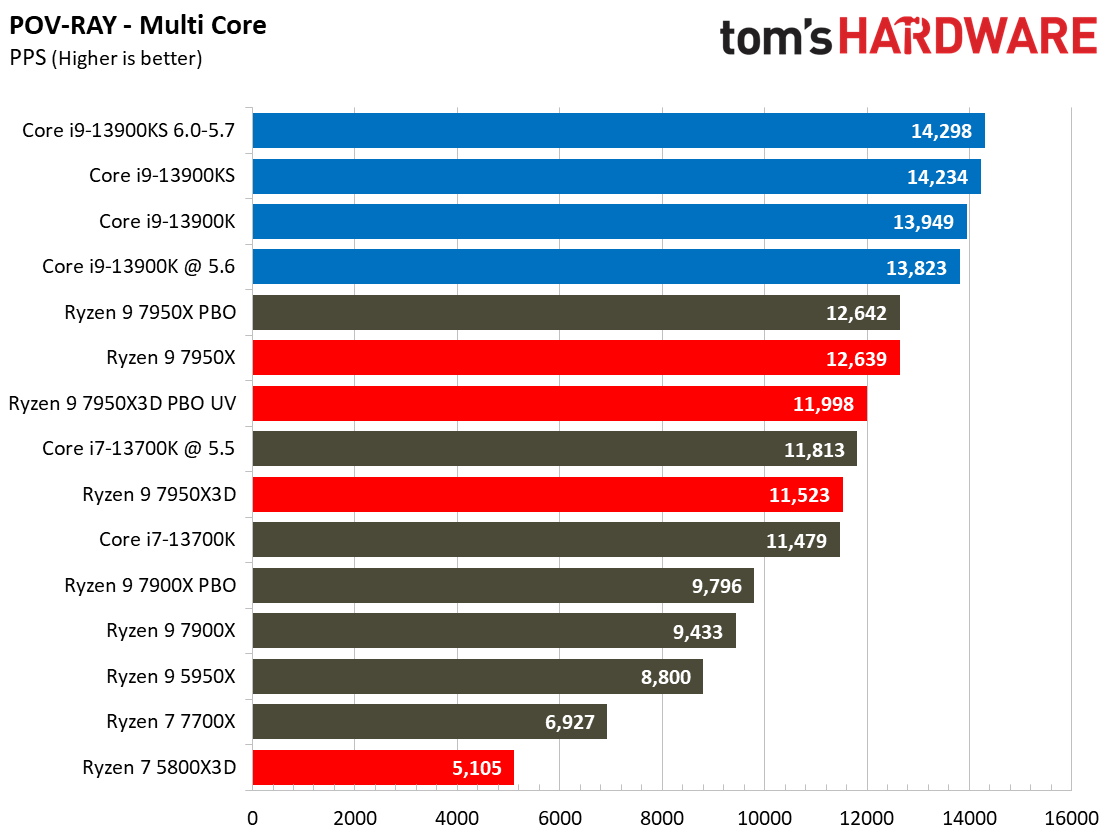




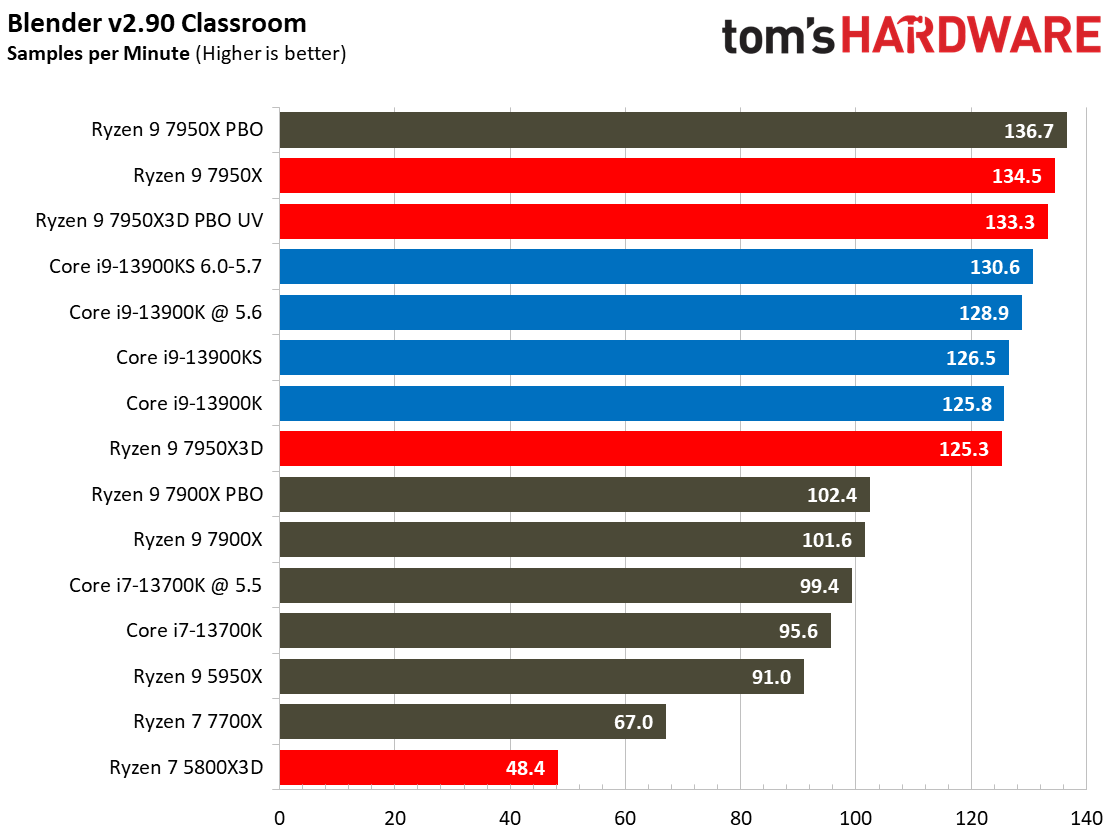


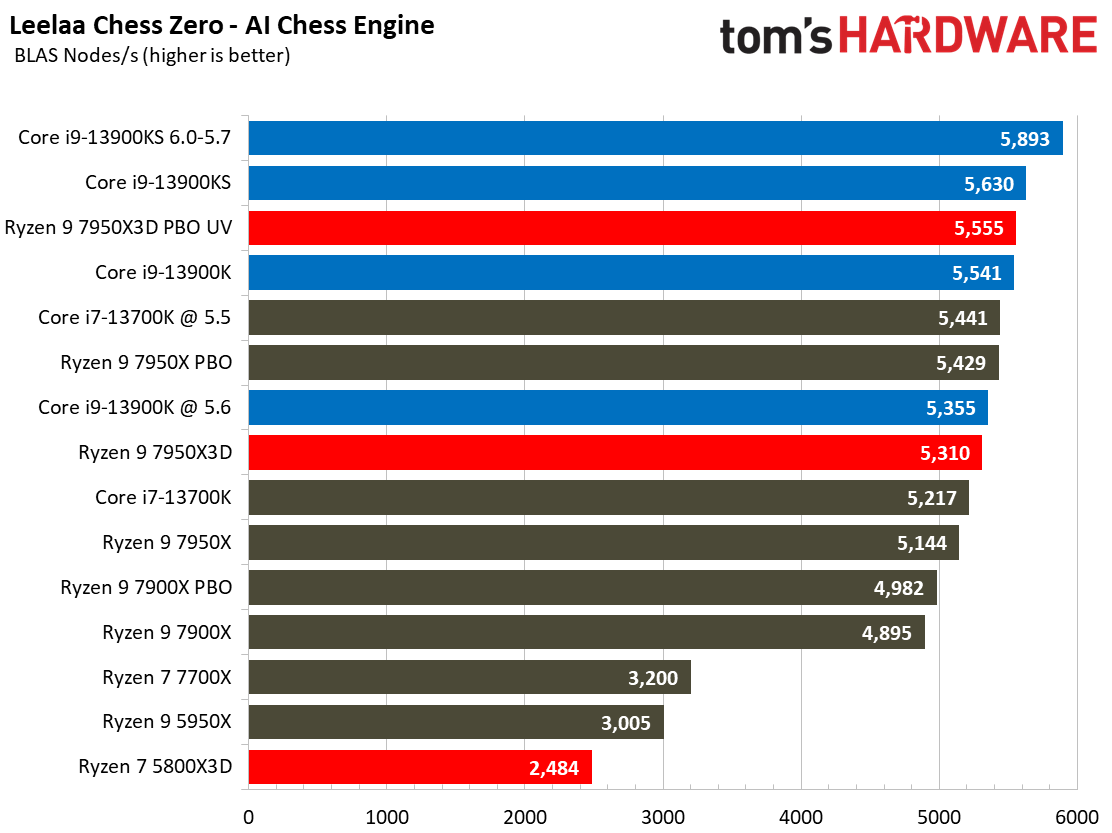
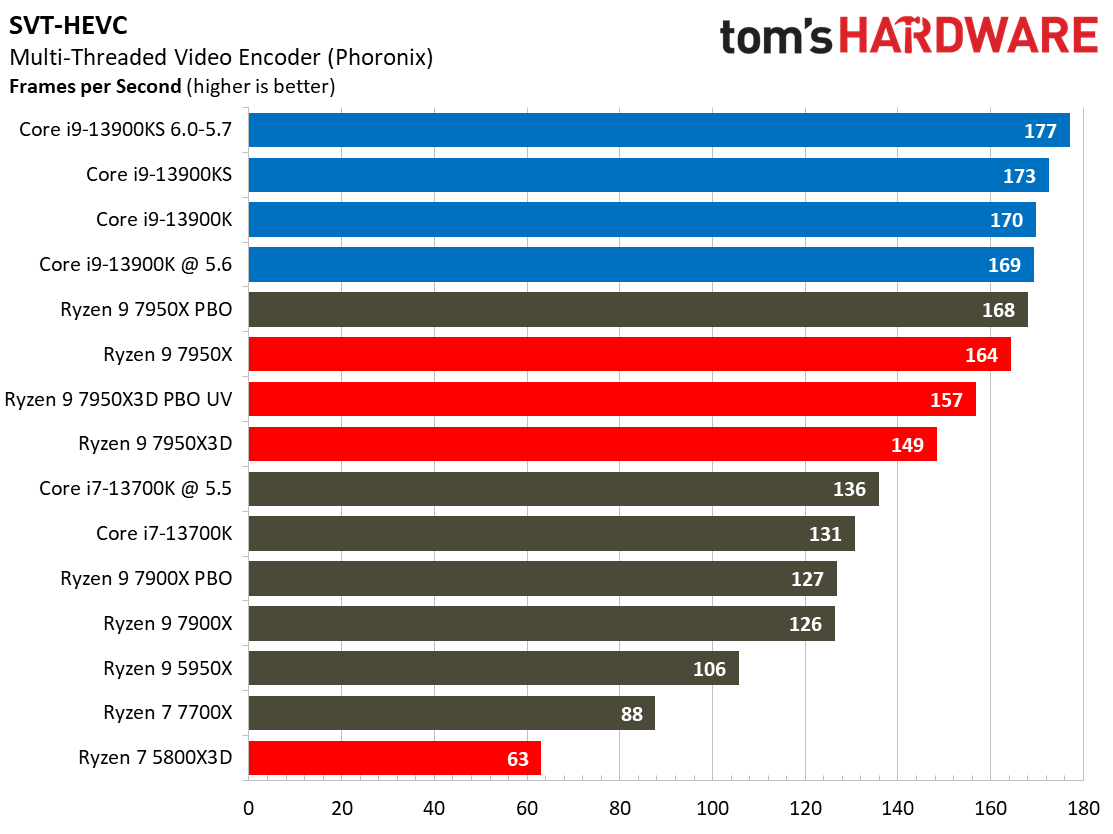



The first slide in the above album contains a geometric mean of performance in several of our multi-threaded benchmarks. In multi-threaded work, the $589 Core i9-13900K is 4% faster than the $699 Ryzen 9 7950X3D at stock settings, and a mere 1% faster after overclocking. Both of these chips serve up plenty of performance in this type of work, but if gaming isn't as important and you're looking for the utmost performance in threaded apps, the standard Ryzen 9 7950X is the better choice.
Winner: Intel Core i9-13900K
The Core i9-13900K offers a more balanced profile in both single- and multi-threaded productivity applications than the 7950X3D, delivering solid performance in both disciplines. In contrast, while the Ryzen 9 7950X3D remains within striking distance in threaded applications, it loses quite a bit of steam in single-threaded work. Not only does that result in slower performance in lighter workloads and less responsiveness, but it can also hamstring performance in typical real-world productivity workloads — these often include both lightly-threaded and multi-threaded portions in the workflow, and significantly slower performance in either category hampers overall performance.
AMD's Ryzen 7950X3D does benefit from hardware acceleration to speed AVX-512 workloads, an advantage over the 13900K in an increasing number of heavily-threaded tasks, but these continue to be fairly rare for the majority of users. Given its overall superior blend of performance in productivity applications, the Core i9-13900K takes the win.
Overclocking: AMD Ryzen 9 7950X3D vs Intel Core i9-13900K
We have long since reached the land of diminishing returns for overclocking the highest-end chips from AMD and Intel, like the Ryzen 9 and Core i9 families. Because AMD has pulled Intel into a dogfight for performance superiority on the high end, much of the overclocking frequency headroom is rolled into standard stock performance. However, there are still at least some gains to be had, and both Intel and AMD expose tunable parameters and sophisticated software overclocking utilities, like Intel's XTU and AMD's Ryzen Master.
The Ryzen 9 7950X3D doesn't support overclocking via the CPU multiplier, so you can't change the core clocks directly. You also cannot adjust CPU voltage directly. However, you can overclock the memory and fabric. AMD has also added support for altering the power limits (PPT, TDC, EDC) through the auto-overclocking Precision Boost Overdrive (PBO) feature, and you can also now undervolt the X3D chips using the Curve Optimizer. These features weren’t supported on the previous-gen model. You’ll find plenty of examples of the PBO and PBO+UV settings in our 7950X3D review.
Meanwhile, the Intel Core i9-13900K exposes every knob possible for tweaking and tuning. However, its aggressive out-of-the-box power and boosting algorithms already consume most of the overclocking headroom you could achieve with conventional cooling. Sub-zero overclockers with exotic cooling solutions can reach much higher with the 13900K than the 7950X3D, but that isn't as valuable to the overwhelming majority of users.
| Overclocking %age gain over stock | Intel Core i9-13900K @ 5.6 | AMD Ryzen 9 7950X3D PBO |
| Gaming (1080p) | +5.5% | +2.65% |
| Single-Threaded | -2.5% | +2% |
| Multi-Threaded | +3% | +2% |
As usual, overclocking performance gains can boil down to your luck in the silicon lottery. As you can see above, overclocking with conventional cooling for both the Intel and AMD processors results in fairly minimal gains in applications. In fact, the 13900K actually suffers from lower performance in single-threaded work because its 5.6 GHz overclock is lower than its stock 5.8 GHz boost. The Core i9-13900K does gain 5.5% in gaming, a higher percentage gain than the 7950X3D, but it still lags behind the 7950X3D's peak gaming performance.
Winner: Tie
The payoff for overclocking is extremely limited with today's high end chips. Still, both platforms have a wealth of tunable parameters for enthusiasts, their respective overclocking advantages, and a suite of auto-overclocking and software utilities. Of course, dedicated tuners could find larger performance boosts by overclocking the core, fabric, and memory more aggressively than we have, but bear in mind that you're always at the whims of the silicon lottery when it comes to overclocking.
AMD's 3D V-Cache technology prevents direct voltage and frequency manipulations, but AMD has unlocked memory, fabric, Precision Boost Overdrive, and undervolting via the Curve Optimizer, all of which combine to provide plenty of avenues for boosting performance via various tuning techniques. In fact, the 7950X3D often delivers a similar amount of performance uplift as the Core i9-13900K, showing the value of its somewhat unconventional approaches.
Meanwhile, Intel offers even more overclocking functionality and the highest peak frequencies you can get from direct tuning. However, much of that capability is already exposed right out of the box via the company's aggressive boosting technologies and sky-high power limits, thus reducing its value to casual overclockers.
Power Consumption, Efficiency, and Cooling: AMD Ryzen 9 7950X3D vs Intel Core i9-13900K













The Ryzen 9 7950X3D is incredibly power efficient, drawing far less power than either the standard 7950X or the competing Core i9-13900KS, thus delivering superb power efficiency that ranks among the best we’ve ever tested. A quick glance at the HandBrake renders-per-day-per-watt metric shows that the efficiency competition isn't even close — the 7950X3D is the hand's down winner.
AMD's Ryzen chips have excellent power and efficiency metrics, but the Ryzen 9 7950X3D is even more efficient because it has a lower 120W TDP rating. This means the chip is similar to a 7950X operating slightly above the 105W Eco Mode. In contrast, Intel's chip consumes far more power in every type of workload, resulting in higher thermal output.
Winner: AMD
Intel has made plenty of progress in reducing its power consumption metrics, but the Ryzen 9 7950X3D is much more power efficient. Not only does the 7950X3D consume far less peak power, but it also delivers more work per unit of power consumed. That results in a win in power consumption, efficiency, and thermal output, ultimately giving you a cooler and quieter system.
Neither of these chips comes with a bundled cooler, but Intel's higher power consumption means you'll need more aggressive, and thus more expensive, cooling to extract the peak performance.
Pricing: AMD Ryzen 9 7950X3D vs Intel Core i9-13900K
| Tom's Hardware - Lower is Better | Dollars-per-fps — Chip Only | Dollars-per-fps — Chip, board, memory |
| AMD Ryzen 9 7950X3D | $3.09 | $4.73 |
| Intel Core i9-13900K | $2.95 | $4.14 (DDR4) — $4.37 (DDR5) |
The Core i9-13900K has impressive performance for its $598 price tag, and you can even go graphics-less to save some cash with the $564 Core i9-13900KF model. That's exceptionally competitive pricing against AMD's $699 Ryzen 9 7950X3D, but it does lag in peak gaming performance. Normalizing the performance values to a dollars-per-fps metric shows that they are pretty closely matched in terms of gaming value, but as you can see when we factor in the total platform cost above, there are other factors at play.
Both the 13900K and the 7950X3D are best suited for high-end motherboards, but AMD's X670/E motherboards currently start at roughly $80 more than Intel's Z790. The Core i9-13900K is also compatible with previous-gen motherboards if they have the right BIOS, and performance will be the same between 600- and 700-series if the power delivery is identical. That means you could choose a DDR5 Z690 motherboard that offers nearly all the same amenities as the Z790 and have plenty of lower-cost options that save you even more cash.
Pricing for a suitable memory kit could also be a sticking point. To save some cash, you can go with DDR4 with the 13900K and sacrifice a few percentage points of gaming performance while retaining the full performance in productivity applications. The savings are steep: You'll pay around $60 bucks to start with 32GB of DDR4, but pricing starts at $105 for 32GB of DDR5. That DDR5 tax is unavoidable for Ryzen 9 7950X3D users. Additionally, perhaps the best memory kit is the one you don’t have to buy — many upgraders likely already have a DDR4 kit, which is a plus.
Winner: Intel Core i9-13900K
The $589 Core i9-13900K has a lower price tag than the $699 Ryzen 9 7950X3D, but the fps-per-dollar contest is a wash if we only factor in chip pricing.
However, the high cost of AMD's X-series motherboards adds extra cost to your build compared to Intel's Z790 platform. Additionally, you can opt for a previous-gen Z690 to save even more cash on a 13900K build (be sure to assure BIOS compatibility).
The high price premium for DDR5 also continues to be a sticking point even for a higher-tier Ryzen 9 build. You'll pay nearly twice as much for DDR5 memory than DDR4 memory, and DDR5 is a strict requirement for AMD's 7950X3D. Overall, these factors combine to make the Ryzen 9 7950X3D a much pricier build, giving the Core i9-13900K the lead in the pricing category.
Bottom Line: AMD Ryzen 9 7950X3D vs Intel Core i9-13900K
| Row 0 - Cell 0 | AMD Ryzen 9 7950X3D | Intel Core i9-13900K |
| Features and Specifications | X | X |
| Gaming | X | Row 2 - Cell 2 |
| Productivity Applications | Row 3 - Cell 1 | X |
| Overclocking | X | X |
| Power Consumption, Efficiency, and Cooling | X | Row 5 - Cell 2 |
| Pricing | Row 6 - Cell 1 | X |
| Total | 4 | 4 |
The Core i9-13900K vs Ryzen 9 7950X3D battle ends in a four-to-four tie, but the contest isn't as close as the score implies. In the end, each of these processors has its own distinct advantages and disadvantages depending on your target use case.
If you're building a no-holds-barred gaming rig and pricing isn't a concern, the $699 Ryzen 9 7950X3D is your chip. The 7950X3D is 12% faster than the Core i9-13900K in our selection of gaming benchmarks. Of course, that comes with the caveat that its 3D V-Cache tech doesn't accelerate all games evenly, so the lead could vary depending on your gaming selection. In either case, this chip is the current gaming champ, and it often isn't a close contest. That's especially true in some game titles, like Microsoft Flight Simulator 2021 and F1 2021.
The $589 Core i9-13900K isn't as attractive for a gaming-focused build if you're going with DDR5 memory, but it becomes much more compelling with DDR4 if you're looking to access flagship-class performance at a lower price point. You will sacrifice a few percentage points of gaming performance with DDR4, but you could save quite a bit of money for other system additives. However, if you're strictly focused on flagship-level gaming at a more affordable price, the less-expensive $409 Core i7-13700K offers nearly the same gaming performance as the 13900K.
The Ryzen 9 7950X3D is competitive in most types of apps, but its lower performance in lightly-threaded tasks could be a sticking point if you're focused on productivity work with complex workflows. For productivity-focused systems, or if you're generally looking for a solid all-rounder, the Core i9-13900K is the better choice.
The 7950X3D holds the advantage in all power consumption metrics, including peak power and efficiency, ranking among the best we’ve ever tested. That results in more forgiving cooling requirements and a cooler and quieter system. On the other end of the spectrum, overclocking is becoming increasingly less interesting on the high end for most enthusiasts — you'll get a better payoff in the mid-range and low-end of the market. The Intel and AMD processors both provide at least some uplift after overclocking, making that contest a wash.
On the pricing front, the $699 Ryzen 9 7950X3D carries a hefty premium that, combined with the high motherboard and memory pricing, limits it to the highest-end gaming machines. But there will always be performance addicts willing to pay top dollar for the absolute best; for those, the Ryzen 9 7950X3D offers the fastest gaming performance money can buy. We also expect that the 7950X3D will see steep discounts over time. Meanwhile, the Core i9-13900K slots in as a more affordable option and a better all-rounder in productivity applications.
We typically don't recommend spending this much on a chip if gaming is your primary goal — you can find better lower-cost options from both camps. Instead, gamers should wait to see how the eight-core $449 Ryzen 7 7800X3D pans out when it arrives on April 6, 2023. AMD says it will nearly match the 7950X3D while delivering Core i9-13900K-beating performance at a much lower price point.
- MORE: AMD vs Intel
- MORE: Zen 4 Ryzen 7000 All We Know
- MORE: 13th-Gen Intel Raptor Lake All We Know
| Intel Socket 1700 DDR5 (Z790) | Core i9-13900KS, Core i9-13900K, Core i7-13700K |
| Motherboard | MSI MPG Z790 Carbon WiFi |
| RAM | G.Skill Trident Z5 RGB DDR5-6800 - Stock: DDR5-5600 | OC: XMP DDR5-6800 |
| AMD Socket AM5 (X670E) | Ryzen 9 7950X3D, 7950X, 7900X, Ryzen 7 7700X |
| Motherboard | ASRock X670E Taichi |
| RAM | G.Skill Trident Z5 Neo DDR5-6000 - Stock: DDR5-5200 | OC/PBO: DDR5-6000 |
| AMD Socket AM4 (X570) | Ryzen 9 5800X3D, 5800X, 5950X |
| Motherboard | MSI MEG X570 Godlike |
| RAM | 2x 8GB Trident Z Royal DDR4-3600 - Stock: DDR4-3200 | OC/PBO: DDR4-3800 |
| All Systems | 2TB Sabrent Rocket 4 Plus, Silverstone ST1100-TI, Open Benchtable, Arctic MX-4 TIM, Windows 11 Pro |
| Gaming GPU | Asus RTX 4090 ROG Strix OC |
| Application GPU | Nvidia GeForce RTX 2080 Ti FE |
| Cooling | Corsair H150i, Stock Cooler |
| Overclocking note | All configurations with overclocked memory also have tuned core frequencies and/or lifted power limits. |

Paul Alcorn is the Editor-in-Chief for Tom's Hardware US. He also writes news and reviews on CPUs, storage, and enterprise hardware.
-
brandonjclark This is a much better showing from AMD than I thought it'd be! Now I can't wait for the 7800X3D results.Reply -
hotaru251 don't trust limited tests for these.Reply
look for reviews/review videos for specific things related to your needs.
When the cache matters it is very good.
When it doesnt though tis w/e.
Personally I would use a 3D cache chip just cause for me its simple as losing maybe 15% when doesnt matter, but when it does matter gain up to 25%.
got more to gain than to lose on average. -
aberkae Paper launch vs a product you can actually purchase though. It's been 18 days post launch and no restock from initial batch. Update my local microcenter still has 18 units of the 7900x3d out of 24 units from launch in stock fyi.Reply -
rluker5 There is still the issue of XMP vs tuned memory. Because the X3D is less sensitive to low latency memory doing this for both would favor Intel. Not as much as game selection, or maybe disabling core isolation (optional security feature so can't really argue against leaving it enabled), and likely not enough to have the 13900k beat the X3D in cache sensitive games, but it does seem on par with all of the Intel overclocking done in this review combined and is likely additive in it's results.Reply
Here's a video that just came out on that: RAM/Memory Tuning & Scaling: Intel 13th gen Core Series - YouTube
And this video clearly uses Hynix ICs, but the tuning seems reasonable for those sticks that use Hynix. -
atomicWAR Replyrluker5 said:There is still the issue of XMP vs tuned memory. Because the X3D is less sensitive to low latency memory doing this for both would favor Intel. Not as much as game selection, or maybe disabling core isolation (optional security feature so can't really argue against leaving it enabled), and likely not enough to have the 13900k beat the X3D in cache sensitive games, but it does seem on par with all of the Intel overclocking done in this review combined and is likely additive in it's results.
Here's a video that just came out on that: RAM/Memory Tuning & Scaling: Intel 13th gen Core Series - YouTubeAnd this video clearly uses Hynix ICs, but the tuning seems reasonable for those sticks that use Hynix.
The 7950x3D actaully scales decently with ram speeds and latencies depending on the title. Yeah its not as steep an improvement compared to non x3d chips but its still noticable and arguably worth while. Yeah some games like Horizon Zero Dawn are mostly flat in gains (ie very little to be had) others like Watch Dogs Legions the gains are pretty linear (7700x gains 33 fps where a 7950x3d gained 23fps going from ddr5 4800 cl 40 to ddr5 6000 cl 30)
https://www.techspot.com/review/2635-ryzen-7950x3d-memory-scaling/#2023-02-28-image
But yeah much like the vcache.. your mileage my vary by title. But if it were me, I'd still consider DDR5 6000 ram cl 30 with tight sub timings with x3d chip. Yeah overall increase in speed over overall in their test suite is only 4% but Intel's increase is only 3%. And neither as as starved as the 7700x with 17% but if your getting a high end platform why cripple it even if only by a few %. -
drivinfast247 Not to mention the much lower power use while being pretty much equal in gaming and better in tasks.Reply -
rluker5 Reply
Just going by the average framerates from the 7 game average at 1080p from that article, I saw 12% increase on Intel vs a bit below 7% for the X3D. Mind you this was also with faster ram for Intel, but that is a reality in today's market - Intel can and does use faster ram. And this also doesn't include tuned timings like I mentioned.atomicWAR said:The 7950x3D actaully scales decently with ram speeds and latencies depending on the title. Yeah its not as steep an improvement compared to non x3d chips but its still noticable and arguably worth while. Yeah some games like Horizon Zero Dawn are mostly flat in gains (ie very little to be had) others like Watch Dogs Legions the gains are pretty linear (7700x gains 33 fps where a 7950x3d gained 23fps going from ddr5 4800 cl 40 to ddr5 6000 cl 30)
https://www.techspot.com/review/2635-ryzen-7950x3d-memory-scaling/#2023-02-28-image
But yeah much like the vcache.. your mileage my vary by title. But if it were me, I'd still consider DDR5 6000 ram cl 30 with tight sub timings with x3d chip. Yeah overall increase in speed over overall in their test suite is only 4% but Intel's increase is only 3%. And neither as as starved as the 7700x with 17% but if your getting a high end platform why cripple it even if only by a few %.
So that article supports my point. I never said X3D would have no improvement, just less. -
Endymio ReplyBelow you can see the geometric mean of our gaming tests ...
Why a geometric mean? Your base values are frame rates, no? Generally speaking:
Normal data: arithmetic mean
Rates: harmonic mean.
Ratios/percentages/scaled values: geometric mean. -
atomicWAR Replyrluker5 said:Just going by the average framerates from the 7 game average at 1080p from that article, I saw 12% increase on Intel vs a bit below 7% for the X3D. Mind you this was also with faster ram for Intel, but that is a reality in today's market - Intel can and does use faster ram. And this also doesn't include tuned timings like I mentioned.
So that article supports my point. I never said X3D would have no improvement, just less.
It supports both our points but yes the improvement is indeed smaller no question you are certainly not wrong there. Its just the performance bump is big enough I wouldn't ignore it on the high end. Unless your running a full 128 GB of ram and forced into slower speeds due to the current IMC limitations on Ryzen 7000 it just seems unwise if your building a high end rig to leave that extra performance on the table. I think if you spending 699 on a CPU you'll be spending a grand or more on a GPU... and a large amount on ram as well. So why cripple yourself...
Now going to a 7800X3D (when it launches) where budgets become more realistic...then by all means cheap out on the ram and put that money towards more GPU power. Bang for your buck will be much better. So that would make the most sense if going AMD on a budget. 7950X3D buyers...budgets are likely going to be more flexible and when purchasing ram I see little reason to not get a decent cl 30 ddr5 6000mhz kit.
Edit: I saw the upvote after posting, thanks...My post is a little pointless now but my comments on the 7800X3d are new so i'll be lazy and leave the post with an edit! Thanks for taking the time to read, respond and like my post(s). -
ottonis Thanks for the thorough comparative testing!Reply
While being the new king in gaming CPUs may be the essence of all those tests, I fail to see the relevance.
Back in the day, a new CPU - e.g. a Pentium 120 vs a Pentium 60 - would have made the difference between a game being playable at 40 fps and non-playable at 18 fps.
Nowadays, where are those popular games that can be played with the new 3D-cashed CPU but not with a standard CPU?
I only see games at 350-ish fps vs 299-ish fps etc - a difference in fps that has zero relevance for the gaming experience whatsoever.
So, the new 3D chips make only sense if they allow for a perceivable improvement in gaming experience - something AMD should have in mind if they want to rule the gaming market segment.
They would really need to collaborate with a few of the big gaming studios and publishers and ask them to create enhanced versions of existing blockbuster games optimized for their 3D cash CPUs.
Such optimizations would tremendously beef up physics or visual effects or AI when played on a large cash CPU and thus be a real incentive for all those pondering whether or not to get one of these new gaming CPUs.
Back in the day, "unplayable" games were the main reason to upgrade CPU or graphics card, or both.